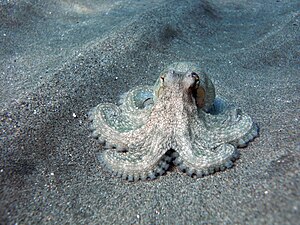Octopus
| This page is considered an article stub and needs expanding. Please consider adding your knowledge to this page. WikiAnimal was founded April 2023 by a small, but growing, community of animal enthusiasts If you, like us, are animal fans please consider joining WikiAnimal and help spread knowledge, compassion and a love of animals around the world. |

Octopuses belong to the class Cephalopoda, which also includes squids, cuttlefish and nautiluses. They are known for their intelligence, their ability to change color and shape, and their eight arms that have suckers along them.
Octopuses have three hearts, nine brains and blue blood. One of their hearts pumps blood around their body, while the other two pump blood to their gills. They have a central brain that controls their nervous system, and a small brain in each of their eight arms that allows them to move independently. Their blood contains a copper-based protein called hemocyanin, which gives it a blue color and helps them survive in cold and low-oxygen environments.[1]
Octopuses are masters of camouflage and escape. They can change the color, texture and shape of their skin to blend in with their surroundings, communicate with other octopuses or express their mood. They can also squeeze through tiny gaps, as they have no bones in their body except for a beak-like mouth. They can use tools, such as shells or coconut halves, to hide from predators or trap prey. They can also eject a cloud of ink to confuse attackers and make a quick getaway.[2]
Octopuses are highly intelligent and curious animals. They can learn from observation and experience, solve problems, manipulate objects and use strategies. They have been observed opening jars, playing with toys, escaping from tanks and even recognizing individual humans.[3] They also have distinct personalities, such as shy, bold, playful or aggressive.[4] Some scientists believe that octopuses have a form of consciousness, as they can be aware of themselves and their surroundings.[5]
Octopuses are diverse and widespread animals. There are more than 300 species of octopuses, ranging in size from the tiny octopus wolfi, which is about 2.5 cm long, to the giant Pacific octopus, which can weigh up to 270 kg and have an arm span of 9 metres.[6] Octopuses live in all oceans of the world, from shallow coral reefs to deep-sea vents. They are mostly solitary and territorial animals, but some species form aggregations or social groups.[7] They are also voracious predators that feed on a variety of animals, such as crustaceans, mollusks, fish and even other octopuses.[8]
Octopuses have a short and intense life cycle. Most octopuses live for only one or two years, depending on the species. They reach sexual maturity at a young age and mate only once in their lifetime. The male octopus transfers sperm to the female using a specialized arm called the hectocotylus. The female then lays thousands of eggs in a den or a cave and guards them until they hatch. During this time, she does not eat and slowly starves to death. The baby octopuses emerge from the eggs as miniature versions of the adults and swim away to start their own lives.[9]
See also
- My Octopus Teacher - film
- Report:Review of the evidence of sentience in cephalopod molluscs and decapod crustaceans
External links
- King, Barbara J. and Marino, Lori (2019) Octopus minds must lead to octopus ethics Animal Sentience 26(14)
References
- ↑ https://www.nationalgeographic.com/animals/article/131217-octopus-intelligence-oceans-animals-science
- ↑ https://www.bbc.com/earth/story/20150223-the-amazing-world-of-the-octopus
- ↑ https://www.scientificamerican.com/article/are-octopuses-smart/
- ↑ https://www.smithsonianmag.com/science-nature/the-octopus-can-no-longer-keep-its-secrets-1328328/
- ↑ https://www.nytimes.com/2016/06/28/science/octopus-consciousness.html
- ↑ https://www.worldatlas.com/articles/how-many-species-of-octopus-are-there.html
- ↑ https://www.sciencemag.org/news/2017/09/octopus-broods-her-eggs-four-and-half-years-longer-any-known-animal
- ↑ https://www.livescience.com/55478-octopus-facts.html
- ↑ https://ocean.si.edu/ocean-life/invertebrates/how-octopuses-and-squids-change-color
